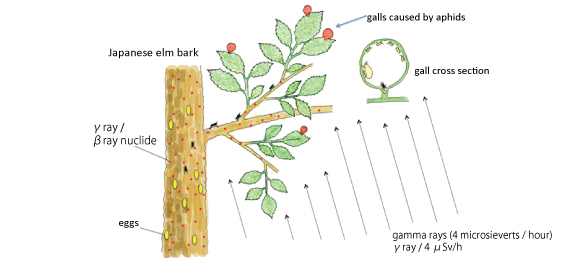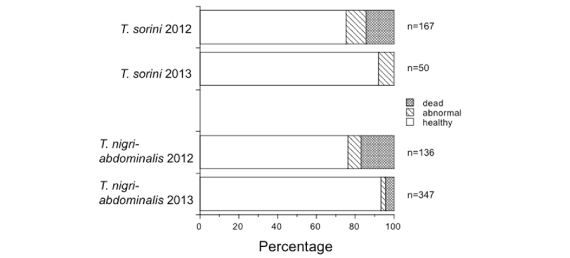Impacts of radioactive fallout on insects in Fukushima; initial adverse effect and recovery of populations
Research Press Release | March 25, 2014
-
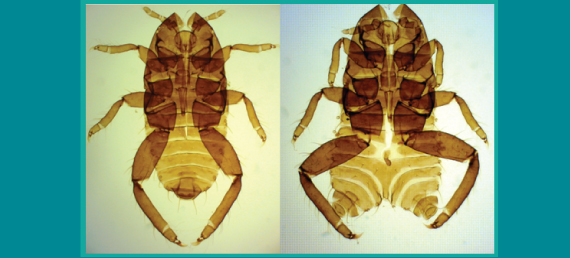 Fig. 1A Normal (left) and malformed (right) first instars of Tetraneura sorini.
Fig. 1A Normal (left) and malformed (right) first instars of Tetraneura sorini. -
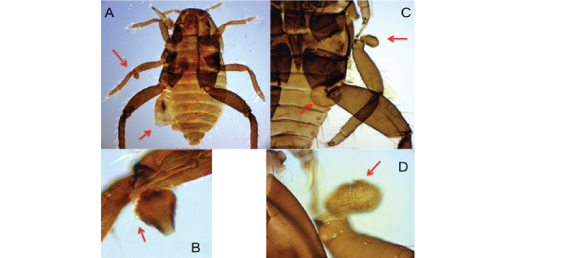 Fig. 1B Malformed first instars of Tetraneura sorini. A: A dead first instar having a distended abdomen (arrow) and a projection on the joint of the mid-femur and tibia (arrow). B: Projection having a seta (arrow). C: A dead first instar having protuberances on the abdomen (arrow) and the base of the mid-leg (arrow). The mid-leg was transposed from the original position. D: Protuberance on the base of the trochanter.
Fig. 1B Malformed first instars of Tetraneura sorini. A: A dead first instar having a distended abdomen (arrow) and a projection on the joint of the mid-femur and tibia (arrow). B: Projection having a seta (arrow). C: A dead first instar having protuberances on the abdomen (arrow) and the base of the mid-leg (arrow). The mid-leg was transposed from the original position. D: Protuberance on the base of the trochanter. -
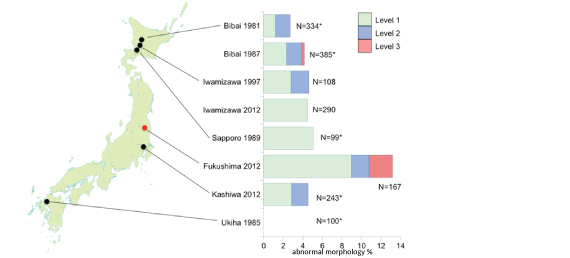 Fig. 2. Percentage abnormal morphologies in Tetraneura sorini first-instar gall formers from 8 populations.
Fig. 2. Percentage abnormal morphologies in Tetraneura sorini first-instar gall formers from 8 populations.
| Press Release | ||
|---|---|---|
| Key Points |
・High mortality and morphological abnormality were detected in two species of gall-forming aphids in a highly contaminated area of Fukushima in 2012. ・In 2013, however, the proportion of healthy individuals increased, and this suggests the recovery of the population. |
|
| Overview |
Increasing attention has been paid to the effects of radioactive fallout from the Fukushima Daiichi nuclear accident on wildlife. However, there is limited knowledge about the effects of radiation. This study detected higher proportions of mortality and morphological abnormalities in two species of gall-forming aphids in a highly contaminated area in Fukushima in the spring of 2012. Several lines of evidence suggest radioactive fallout as the most likely cause for the morphological abnormalities; however, in the spring of 2013, the proportion of healthy aphids increased in the populations. This suggests that aphid populations are recovering from the initial impact of fallout. This study, for the first time, provided evidence of population recovery from the adverse effect of fallout. |
|
|
Research in Detail |
As there is still limited knowledge about the effects of radioactive contamination on wildlife, this study attempts to evaluate the initial impact of fallout on small insects in the area northwest of the Fukushima Daiichi Power Plant which was highly contaminated by radioactive substances. There was much controversy as to the first report of morphological abnormalities in the pale grass blue butterfly (Hiyama et al. 2012) in Fukushima. The present study reports the second example of morphological abnormalities in insects by comparing first instars of several generations across two years. Gall-forming aphids grow in closed galls where they produce their offspring, so it is easy to detect fecundity, mortality, and morphological abnormalities. Of 167 first instars from Tetraneura sorini galls collected 32 km from Fukushima Daiichi in the spring of 2012, 13.2% exhibited morphological abnormalities, including 4 conspicuously malformed individuals (2.4%). In contrast, in 7 control areas, first instars with abnormal morphology accounted for 0.0%-5.1% (on average, 3.8%). The proportions of abnormalities and mortality were significantly higher in Fukushima than in the control areas. However, of 543 second-generation larvae produced in T. sorini galls, only 0.37% had abnormalities, suggesting that abnormalities found in the first generation were not inherited by the next generation. Furthermore, analysis of samples collected in the spring of 2013 indicated that the viability and healthiness of the aphids were significantly improved compared to those in the 2012 samples. Thus, the results of the present study suggest that a reduced level of radiation and/or selection for radiation tolerance may have led to the improved viability and healthiness of the Fukushima population. The impact of fallout appeared immediately after the accident. However, the present study suggests the possibility that for aphids that have 10 generations per year with a high reproductive rate, the population overcomes the initial adverse effects of fallout and gradually recovers. Fig. 3. First instars of the first generation that hatches from eggs on tree bark and those of the second generation. Eggs are deposited on the contaminated bark, while the second generation is produced in non-contaminated galls. Fig. 4. Comparison of the fates of gall formers collected from one elm tree in the Fukushima area between 2012 and 2013. Gall formers in the galls were categorized into 3 groups: healthy, morphological abnormal, and dead aphids. |
|
| Inquiries |
Shin-ichi Akimoto, Professor, Laboratory of Systematic Entomology, Department of Ecology and Systematics, Graduate School of Agriculture, Hokkaido University TEL: +81-11-706-2480 FAX: +81-11-706-2494 E-mail: akimoto@res.agr.hokudai.ac.jp |
|
|
Japanese Link |
原発事故に伴う放射性降下物の昆虫へのインパクトとそこからの回復過程を初めて解明 | |
| Publications | Ecology and Evolution, Volume 4, Issue 4, pages 355–369,2014 (2014.1.13) | |

